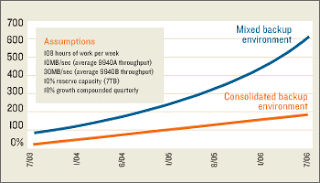
It's just a data point, but note that Asus, the Taiwanese computer maker, is planning on bringing to market a notebook PC with two 500 GByte hard drives from Hitachi Global Storage Technologies.
That's a terabyte. Those of you familiar with enterprise storage, think about it: a terabyte per user. Those of you who have to do your own backups, think about it: losing a significant portion of 1 Tbyte of data if your hard disks crash.
The upside is that such a user can 1,000 hours of video, or more than 350 feature length movies, or 250,000 four-minute songs. The downside? If those files are not backed up someplace, huge collections of audio or video can vanish.
The point is that storage continues to emerge as a function that is becoming harder to manage. It is harder to backup, harder to restore, harder to secure, index and retrieve. Part of the reason is that simply is so much more information to store. This graphic from searchstorage.com simply makes the point that storage and backup requirements grow steadily.
Which makes the argument for storage in the cloud ever more compelling. If one's authorized copies of music, video or other material are stored in the cloud, local hard drives can crash with little threat of losing the content. Not to mention that the files can be used on any number of endpoints (I didn't say downloaded to those endpoints).



